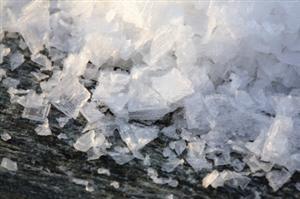| Complexity level: | 7 |
| Project cost ($): | 10 |
| Time required: | 1 hour for preparation, 10 days to conduct the science fair project |
| Material availability: | Easily found |
| Safety concerns: | Handle the ammonia carefully. |
Hypothesis
When more ammonia used, more salt crystals are formed.
Overview
Salt crystallization
Crystals are an organized arrangement of atoms and molecules, with each type of crystal having its own shape and properties. Salt crystals are made from sodium (Na) and chlorine (Cl) atoms and have a cubic shape. A salt solution will contain sodium and chlorine atoms that are separated by water molecules. When the water evaporates from the solution, the sodium and chlorine atoms start bonding together to form crystals.
Placing a porous material like a sponge, charcoal or broken ceramic in the salt solution helps to draw in the mixture through capillary action. The water will evaporate from the surface of the porous material, leaving behind crystals. The crystallization process is driven by the evaporation of water and placing the solution in a dry place or under a slight breeze will help the crystals to grow faster.
A laundry agent known as bluing liquid is sometimes used to help the crystals to form. It contains a fine powder that acts as a nucleation site for crystals to grow. Bluing liquid also contains an iron compound that will react with ammonia to form iron salts.
Scientific Terms
Materials
The materials required for the science fair project:
- 5 bowls
- 4 sponges
- 1 packet of salt
- 1 bottle of bluing liquid (used in laundry)
- 1 bottle of ammonia
- 1 tablespoon
- 1 caliper
Procedure
1. For this science fair project, the independent variable is the composition of compounds used in the salt solution. The dependent variable is the amount of salt crystals formed. This is determined through observation and by measuring the height of crystals on the sponge using a caliper. The constants (control variables) are the size of the sponge, the temperature, humidity and air flow of the environment, and the size of the bowls used.
2. Wash, clean and dry the 4 bowls. Then, line up the bowls and label them as ‘Bowl 1’, ‘Bowl 2’, ‘Bowl 3’ and ‘Bowl 4’ respectively. Add the following ingredients to each bowl and mix thoroughly:
a. Bowl 1 – 3 tablespoons of salt and 3 tablespoons of water
b. Bowl 2 - 3 tablespoons of salt, 3 tablespoons of water and 3 tablespoons of bluing liquid
c. Bowl 3 - 3 tablespoons of salt, 3 tablespoons of water, 3 tablespoons of bluing lliquid and 3 tablespoons of ammonia
d. Bowl 4 - 3 tablespoons of salt, 3 tablespoons of water, 3 tablespoons of bluing and 6 tablespoons of ammonia
3. Place a piece of sponge inside each bowl. Leave the bowls in a dry place to allow crystals to form.
4. On the 3rd day, prepare 4 more bowls of solution as mentioned in step 2. Add more liquid to each bowl, taking care not to drip the solution onto the growing crystals.
5. Allow the crystal to grow for a total of 10 days and record your observations in a table, as shown below. Measure the height of the crystals on the sponge with a caliper.
Results
The results show that the solutions in Bowls 1 and 2 that contained only salt, water and bluing did not have much crystallization. The crystallization of salt increased when ammonia was added to Bowls 3 and 4. The more ammonia was added, the more crystallization occurred.
| Ingredient | Observation |
| Bowl 1 | Crystal height of 2.5mm on sponge. Some crystal on edge of owl. |
| Bowl 2 | Crystal height of 2.8mm on sponge. Some crystal on edge of bowl. |
| Bowl 3 | Crystal height of 5.3mm on sponge. Salt crystal grown above bowl height. |
| Bowl 4 | Crystal height of 8.2mm on sponge. Salt crystal overflowing bowl. |
Conclusion
We have proven correct, the hypothesis that when more ammonia is used, more salt crystals are formed.
Salt has been used for thousands of years for food flavoring and preservation. It is also a very important element for the survival of all living creatures including humans, as the presence of salt helps to regulate the amount of water in our bodies. However, consuming too much salt can also lead to health problems, such as hypertension.
Also consider
This science fair project can also be repeated using sugar to form the crystals
The experiment can also be repeated using seawater.
References
What are crystals? - http://www.sciencekidsathome.com/science_topics/what_are_crystals.html
Crystal growing - http://www.waynesthisandthat.com/crystals.htm
Salt - http://en.wikipedia.org/wiki/Salt

